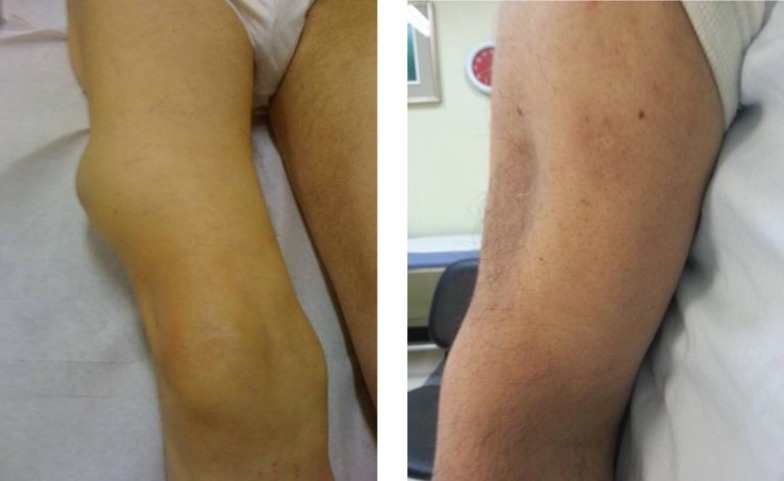The recently published paper by Al Ajlouni et al. (1) describes the rate of lipodystrophy (LD) in a series of 1090 type 2 diabetes (T2DM) patients. LD has been known for decades, and a large body of evidence supports its relationship with poor metabolic control. Nevertheless, LD is often overlooked by teams involved in insulin treatment of people with diabetes mellitus (DM). In their paper, Al Ajlouni et al. (1) confirm a prevalence of 37.3% and a significant association between LD and a series of parameters including female sex, low cultural level, high BMI, long duration of both disease and insulin treatment, use of longest needles, and especially a lack of injection site rotation.
The authors point out that the variability in LH prevalence in several studies may be related to the lack of routine skin examination in diabetes clinics. However, it should be pointed out that such variability may also be due to doctors/nurses having attained different levels of experience and also due to the lack of a clearly defined, validated methodology devoted to LH identification. In fact, the morphological features of such lesions are extremely variable in size, texture, and protrusion above the skin. The attached Table 1 refers to 60 patients with diabetes and ultrasound-ascertained LD undergoing blind palpation-based examination by four well trained and as many non-trained health professionals. It provides evidence that the diagnostic ability differed significantly between the two groups of health professionals, being influenced by both training level and LD morphological features.
Table 1. Cumulative Palpation-Based LH Identification Ability of Non-Trained and Well-Trained Health Professionals as Referred to LH Type and Size in 60 People With Diabetes and Ultrasound-Ascertained LH.
| Variable | Lipohypertrophy Identification Ability of Health Professionals | |||||
|---|---|---|---|---|---|---|
| Non-Trained Professionals | Well Trained Professionals | |||||
| No LH | LH | P Value | No LH | LH | P Value | |
| Correctly diagnosed subjects, No. (%) | 39 (65) | 21 (35) | < 0.001 | 9 (15) | 51 (85) | < 0.001 |
| Lipohypertrophy type, % | ||||||
| Flat | 69 | 29 | < 0.01 | 37 | 63 | < 0.01 |
| Protruding | 29 | 71 | < 0.01 | 0 | 100 | < 0.01 |
| LH size, cm, (mean ± SD) | 4.1 ± 1 | 5.8 ± 1.2 | < 0.001 | 4.0 ± 0.9 | 4.8 ± 1.4 | 0.034 |
Another relevant cause of LD is repeated needle reuse. In fact, when injected into areas of LD, insulin causes a high rate of unexplained hypoglycemic episodes and wide glycemic variability, both of which are not responsive to dosage changes (2, 3). Since educational activity on proper injection techniques in individuals with LD has proven effective in significantly reducing such phenomena (4), we suggest looking systematically for LD lesions in all insulin-treated patients or at least in those displaying repeated unexplained hypoglycemic events and/or wide glycemic variability.
Furthermore, we regret to say that we do not agree with the LD grading method set forth by Al Ajlouni et al. (1), almost suggesting that lipohypertrophy (LH) (grades 1 and 2) and lipoatrophy (LA) (grade 3) express different stages of LH. In our view, being a scarring lesion characterized by subcutaneous fatty tissue atrophy, LA is very different from LH in terms of both morphology (see Figure 1) and pathogenesis. The latter indeed is mainly considered as a consequence of mechanical factors, such as needle reuse and poor injection site rotation (2) as well as typical insulin growth-promoting effects (5), while LA mostly seems to be associated with individual immunoallergic and inflammatory factors (2) and/or with poorly purified insulin preparations (6). This distinction is especially important from a clinical perspective, since, when injected into LA areas, insulin has a much higher chance of reaching into the subcutaneous muscle tissue and thus causing severe hypoglycemic events.
Figure 1. LH Lesion of the Right Thigh (Left Panel) and LA Lesion of the Left Arm (Right Panel).
Acknowledgments
The authors are strongly indebted to the members of the Italian AMD-OSDI study group on injecting techniques for their support in data collection. The names of the members of the study group are available at http://www.aemmedi.it/pages/informazioni/gruppo_amd-osdi_terapia_iniettiva.
Footnotes
Authors’ Contribution:All three authors contributed equally to the present letter.
Financial Disclosure:No funds were granted to the study.
References
- 1.Al Ajlouni M, Abujbara M, Batieha A, Ajlouni K. Prevalence of lipohypertrophy and associated risk factors in insulin-treated patients with type 2 diabetes mellitus. Int J Endocrinol Metab. 2015;13(2):e33997. doi: 10.5812/ijem.20776. [DOI] [PMC free article] [PubMed] [Google Scholar]
- 2.Blanco M, Hernandez MT, Strauss KW, Amaya M. Prevalence and risk factors of lipohypertrophy in insulin-injecting patients with diabetes. Diabetes Metab. 2013;39(5):445–53. doi: 10.1016/j.diabet.2013.05.006. [DOI] [PubMed] [Google Scholar]
- 3.Gentile S, Agrusta M, Guarino G, Carbone L, Cavallaro V, Carucci I, et al. Metabolic consequences of incorrect insulin administration techniques in aging subjects with diabetes. Acta Diabetol. 2011;48(2):121–5. doi: 10.1007/s00592-009-0172-x. [DOI] [PubMed] [Google Scholar]
- 4.Grassi G, Scuntero P, Trepiccioni R, Marubbi F, Strauss KW. Optimizing insulin injection technique and its effect on blood glucose control. J Clin Translational Endocrinol. 2014;1(4):145–50. doi: 10.1016/j.jcte.2014.07.006. [DOI] [PMC free article] [PubMed] [Google Scholar]
- 5.Richardson T, Kerr D. Skin-related complications of insulin therapy: epidemiology and emerging management strategies. Am J Clin Dermatol. 2003;4(10):661–7. doi: 10.2165/00128071-200304100-00001. [DOI] [PubMed] [Google Scholar]
- 6.Holstein A, Stege H, Kovacs P. Lipoatrophy associated with the use of insulin analogues: a new case associated with the use of insulin glargine and review of the literature. Expert Opin Drug Saf. 2010;9(2):225–31. doi: 10.1517/14740330903496402. [DOI] [PubMed] [Google Scholar]



